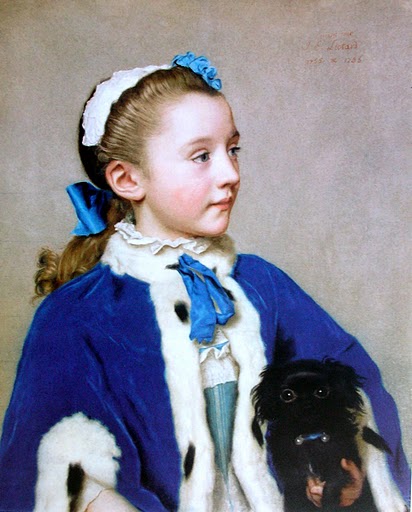 |
| JEAN ETIENNE LIOTARD |
The French-Swiss painter Jean-Etienne Liotard ,was born in 1702 and died in Geneva in 1789, After 1685 ,Jean-Etienne Liotard's father who was a jeweller was fled to Switzerland.
Jean-Etienne Liotard have been taught as a painter miniatures in Geneva, where Jean-Etienne Liotard conquered the exceptional intelligibility of the application will be the hallmark of his style in pastel colors. While in his twenties Jean-Etienne Liotard seek his fortune in Paris, where Jean-Etienne Liotard was studied in a workshop of a leading painter.
Jean-Etienne Liotard began his studies with professor Petitot Gardelle that enamel and miniatures he copied with great talent. Jean-Etienne Liotard arrived in Paris in 1725, and studied underJ. B. Masse and Francois Lemoyne, who made a reference to the Puysieux Mark Naples. In 1735, Jean-Etienne Liotard was in Rome, painting pictures of Pope Clement XII, and several cardinals. After the rejection by the Royal Academy, Jean-Etienne Liotard traveled to Italy, where Jean-Etienne Liotard time-honored numerous commissions from the image. After three years and was accompanied by Lord Duncannon to Constantinople. The acceptance of uniform is eccentrically secured Jean-Etienne Liotard the nickname of the ‘Turkish painter’.
Jean-Etienne Liotard embarked on a journey through the Mediterranean and at last settled in Constantinople for four years. Jean-Etienne Liotard became interested in the original dress, a long beard and got into the habit of clothing and Turkish, and earned the title of "the Turkish painter." During Jean-Etienne Liotard stay in Constantinople, paintings and photographs of members of the British colony.
For the rest of Jean-Etienne Liotard life, Liotard traveled throughout Europe in the portraits of the Bastille. Jean-Etienne Liotard gained an world-wide reputation in this way to get attention and the ability to achieve the almost exact models. At the age of 79, published an article on the principles of painting, which Jean-Etienne Liotard explained his belief that painting is and should be the mirror of nature.
Jean-Etienne Liotard went to Vienna in 1742 to draw portraits of the imperial family.Even outside the auspices ,Jean-Etienne Liotard returned to Paris in 'visiting England, where Jean-Etienne Liotard painted the Princess of Wales in 1753, and went to the Netherlands in 1756, when, in the following year, Jean-Etienne Liotard married Marie Fargues. Followed by a visit to England in 1772, and in the next two years, Jean-Etienne Liotard's name is among the exhibitors at the Royal Academy.He returned to his hometown in 1776. In 1781 he published his Traité Liotard Palace Princes Palace peinture et Règles de Los Angeles. In his last days of the paintings and] interpreted the landscape remains. He returned to his hometown in 1776 and died in Geneva in 1789.
Jean-Etienne Liotard great artist of diversity, and despite Jean-Etienne Liotard reputation depends heavily on pastel elegant and delicate, with 'a reading lamp', 'a girl of chocolate', and 'Abel Lyonnaise' in the gallery of Dresden are examples of delicious successfully distinguish enamel of Jean-Etienne Liotard , Jean-Etienne Liotard also achieved distinction by copperplate engravings and paintings on glass. Jean-Etienne Liotard also wrote a treatise on the art of drawing and was a gathering of experts from the old motherboard. Many of the masterpieces acquired sold at high prices in the second visit to England. Museums Amsterdam, Berne, Geneva and especially rich in examples of Jean-Etienne Liotard paintings and pastels. Picture of the Turkish sitting is the Victoria and Albert Museum, while the British Museum and two of Jean-Etienne Liotard cartoons. The Louvre is 22 drawings, photo's Hrault public image of the artist is in pittori de Sala, the Uffizi Gallery in Florence. While Jean-Etienne Liotard son had married a Dutch girl, has inherited the Rijksmuseum a large group of Jean-Etienne Liotard drawings and paintings .
 |
| JEAN ETIENNE LIOTARD |
 |
| JEAN ETIENNE LIOTARD |
 |
| JEAN ETIENNE LIOTARD |
 |
| JEAN ETIENNE LIOTARD |
 |
| JEAN ETIENNE LIOTARD |
 |
| JEAN ETIENNE LIOTARD |
 |
| JEAN ETIENNE LIOTARD |
 |
| JEAN ETIENNE LIOTARD |
 |
| JEAN ETIENNE LIOTARD |









